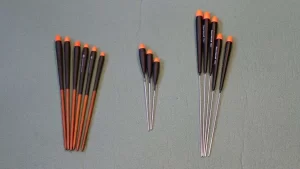Stick floats are a go-to tool for anglers targeting fish in flowing rivers. These long, slender floats are designed to offer stability in moving water, allowing for precise bait presentation and better control over drift. While stick floats have been a staple in European coarse fishing, they’re gaining popularity in the broader fishing community for their versatility. Here’s an in-depth look at stick floats and how to use them for more successful river fishing.
What Are Stick Floats?
Stick floats are designed to fish in fast or moderately flowing rivers. These floats are long and thin with a buoyant top and a less buoyant, streamlined bottom. This design ensures they remain upright in the water, allowing the angler to monitor the float’s movement as it drifts downstream. The float’s thin profile reduces resistance to the water flow, making it more sensitive to bites.
Types of Stick Floats
There are two main types of stick floats:
- Wire Stemmed Floats – These floats feature a wire stem, which adds weight and makes the float more stable in faster waters.
- Plastic Stemmed Floats – Lighter than their wire counterparts, plastic stemmed floats work best in slower-moving currents where sensitivity is more important than stability.
Choosing the Right Float
Selecting the appropriate stick float for the conditions is crucial. For faster rivers, wire stemmed floats are the preferred choice due to their ability to hold steady in strong currents. In slower or moderate currents, lighter plastic stemmed floats allow for more delicate presentations and are better at detecting smaller bites.

Setting Up a Stick Float Rig
To set up a stick float rig, attach the float to the mainline using float rubbers or locking shots. Position the float so it sits slightly above the surface when the bait is at the desired depth. Add split shots below the float to control the drift speed and keep the bait at the correct depth.
Best Baits for Stick Float Fishing
When fishing with a stick float, using the right bait can make all the difference. Live baits like maggots, worms, and small minnows work well, as do natural-looking artificial baits. Match the bait to the local fish species for optimal results.
How to Fish with Stick Floats
Fishing with a stick float is all about controlling the drift. Cast upstream and allow the float to drift naturally downstream with the current. Keep tension on the line to ensure you maintain contact with the float, and be ready to strike when the float dips or moves unexpectedly, indicating a bite.
Common Fish Species Caught with Stick Floats
Stick floats are effective for a variety of species found in rivers, such as trout, grayling, and barbel. Their sensitivity and ability to present baits naturally make them an ideal tool for targeting fish that rely on sight and movement to strike.
Stick floats are a highly effective tool for river fishing, offering anglers better control and precision in moving water. By choosing the right type of stick float and mastering the drift, anglers can improve their catch rates in rivers, making it an essential technique for both novice and seasoned river fishermen. As more anglers discover the advantages of stick floats, they’re becoming a go-to option for river fishing success.
Image: AmateurAngling





